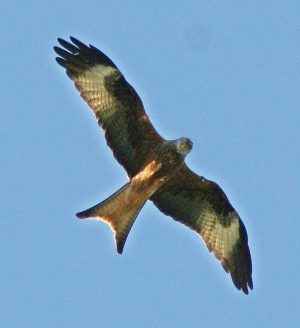The red kite – a woodlandsTV film

Today, we have a new woodlandsTV film about Red Kites.
Whilst the red kite was not an uncommon sight in mediaeval times, come the twentieth century it was a rarity. Indeed, the breeding population was restricted to a few pairs in parts of Wales. The red kite is a bird of prey and belongs to the same ‘family’ as eagles, harriers and buzzards; all are raptors. The kite was first described by Carl von Linne, who gave it the name Falco milvus. A French taxonomist later moved the species to the genus Milvus, so it became Milvus milvus (bit of a tautology that). There are two other species in the Milvus genus : the black kite and the yellow billed kite. The word kite may derive from an ‘old english’ word cyta. The birds are approximately 2 feet long but have an extensive wing span of 5 feet plus. Much of the body is covered with reddish brown feathers, which contrast with primary flight feathers that are white and the black wing tips.
The birds breed when they are two years old (usually) and form a lasting pair bond. Their courtship begins in February and features an impressive aerial display. This display is featured in some detail in the woodlands film about Red Kites (posted on Woodland TV today). The pair bond is maintained through the winter months if they remain in their breeding territory. If they are migratory, they often reunite when they return to the same breeding site.
They often nest high up in the forks of large deciduous trees. The nest may be used several times. Nest building is a task the pair undertake together, the male brings twigs which are arranged by the female -the nest may have some grass or sheep’s wool as a lining. Egg laying occurs at about three day intervals and usually begins in early March. Hatching occurs after some thirty one / thirty two days. Both parents care for the chicks, with the male bringing food to the nest and the female feeding the chicks. Only a single brood is raised each year. The birds have a lifespan of twenty or more years.
As said, the birds are raptors - birds of prey, feeding largely on small mammals such as voles, mice, shrews and young rabbits but also earthworm and carrion (sheep carcasses / dead game birds). Because of their scavenging activities - they are liable to be poisoned - by illegal baits / traps set for foxes or crows. Sadly, like other birds of prey, red kites can be targeted by wildlife criminals.
In recent years, there have been successful re-introductions (of Swedish, Spanish and Welsh birds) in various parts of England and Scotland - for example, the Grizedale Forest in Cumbria; in 2006 a red kite was sighted in London for the first time in over a century.
Comments are closed for this post.
